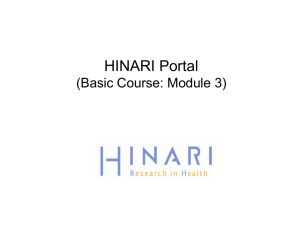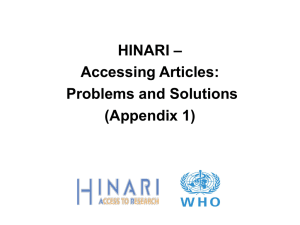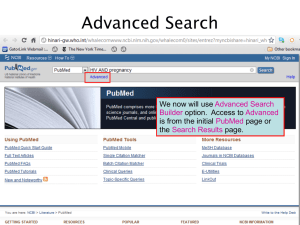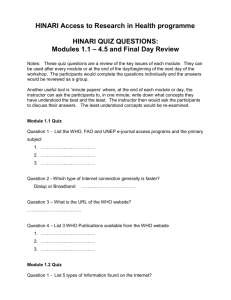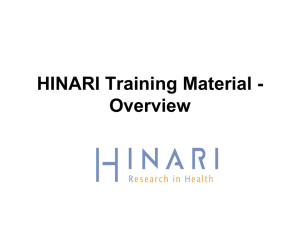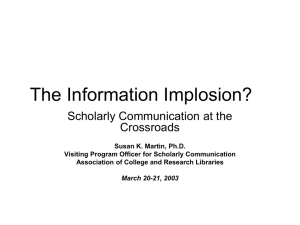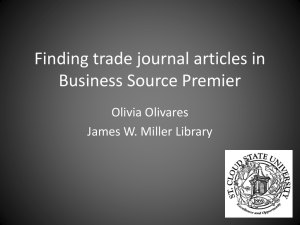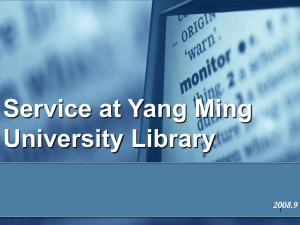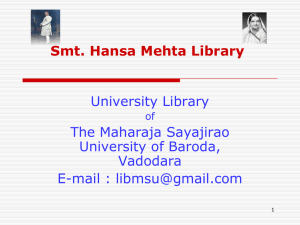Document
advertisement
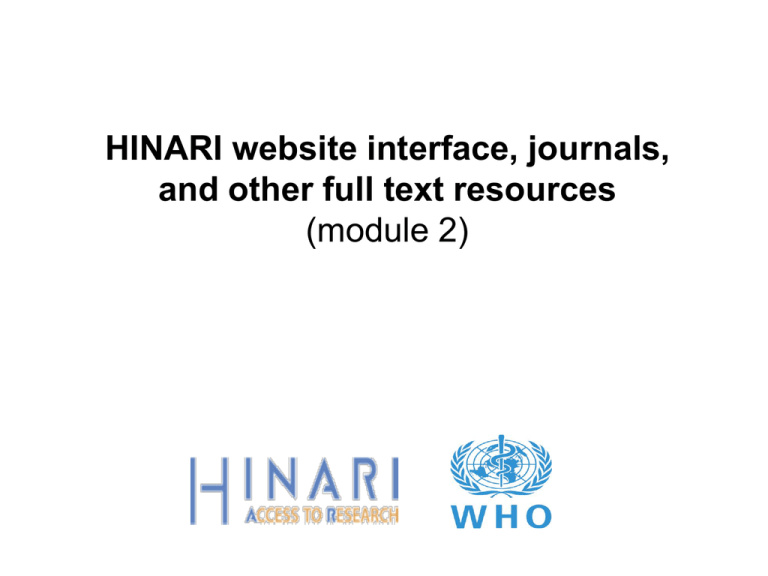
HINARI website interface, journals, and other full text resources (module 2) MODULE 2 HINARI/website interface, journals, and other full text resources Instructions - This part of the: course is a PowerPoint demonstration intended to introduce you to Basic Internet concepts. module is off-line and is intended as an information resource for reference use. Table of Contents Finding the HINARI website Registering to access full-text electronic resources Logging in to the HINARI website Finding journals Finding articles Partner publishers’ websites (continued in module 3) Other full-text resources Other free collections Appendices • HINARI – Accessing Articles: Problems and Solutions • HINARI – Printing, Copying, Saving and Emailing Articles: Problems and Solutions Welcome to the HINARI Homepage Welcome to the HINARI Homepage. This tutorial will look at how to use the HINARI website. The HINARI website address To access the HINARI website, enter the URL http://www.who.int/hinari/ Choose a language option Choose a language option. This tutorial will be in English. Registration 1 Your institution must be registered for you to gain access to the full-text electronic resources. Click on the Register link to access the form – to see if your institution is registered or must complete this process. Before registering your institution, you need to check if your organization already has registered. Click on the REGISTERED UNIVERSITIES AND PROFESSIONAL SCHOOLS link. This list is updated weekly. Note that you also can confirm that your institution is eligible for HINARI by clicking on the (check eligibility) link. From the drop down menu, click on your country – to see the list of registered institutions. For this exercise, we have chosen Viet Nam. If your institution is registered, contact the Librarian or Director for the User Name and Password. If you are not able to do this, contact HINARI at hinari@who.int. Please note that only Universities and Professional Schools are included in these lists. Note: Only ONE registration per institution is required/preferred. This is one of the pages ` of the 'Institution profile' that you will not be able to view. Note the important Contact Details that can contain 'out-of-date' information. For updating contacts, please provide the full names of your country, institution, librarian and/or director, and his/her e-mail address(es), to the trainers or to HINARI via hinari@who.int . Registration 2 Only one registration per institution is required. If not registered, complete form, enter the Registration Check and click on Send Registration. Once the institution is registered, the librarian will receive a HINARI User Name and Password. All members of the institution – researchers, teaching staff, librarians, students etc. – are entitled to use the institution’s User Name and Password. Logging in to HINARI 1 Login to the HINARI website by clicking on LOGIN. Note: If you do not login into HINARI, you will not get access to the full text articles. Workshop User Name/ Password User Name: Password: Logging into HINARI 2 We will need to enter our HINARI User Name and Password in the appropriate boxes, then click on the Login button. Note: If you do not properly sign on, you will not have access to full text articles. If you fail to use the Login page, you will have a second option on the Full text journals, databases, and other resources sub-page. Once logged-in, you will be taken into the Full text journals, databases, and other resources sub-page of the website. Note the ‘You are logged’ in message. This proper login also can be confirmed by the hinari-gw.who.int/whalecommextranet... url Accessing journals by title 1 Journals can be accessed by title from an alphabetical list. For this exercise, click on ‘L’ from the A-Z list. Note: there also is a View complete list of journals option. We have displayed the ‘L’ journal list. Click on the title for The Lancet. The green box notes access to the contents of the journal for you while the ! notes that your institution is denied access (predominantly Band 2 although some Band 1). Note that the ‘years of volumes’ available are listed after the journal title. Accessing journals by title 4 Another window will open at the journal publishers’ website. For each article, there are three options: [Abstract], [Full Text] or [PDF] formats. You can get the article in Full Text or HTML format that includes links to sections of the article, bibliographic citations or related articles. With the PDF or Portable Document Format, you will receive a scanned image of the article. This format is similar to the traditional print option . To download a PDF document, you will need a copy of the Adobe Acrobat program which can be download freely from the Adobe website: http://www.adobe.com Other methods of finding journals Articles can also be found via PubMed, Subject listing, Language, and Publisher. Accessing journals by via PubMed Click on the link to find articles through PubMed. Using PubMed will be covered in subsequent modules. Accessing journals by subject 1 Click on the link to find journals by Subject. Accessing journals by subject 3 From the drop down menu, we have selected Parasitology and Parasitic Diseases. Accessing journals by subject 4 An alphabetical list of Parasitology and Parasitic Diseases journals is now displayed with links to the journal websites. Click on the title Trends in Parasitology After the title of the journal, the available volumes/issues are listed. By clicking on a journal title, you will open the journal in a new window: Trends in Parasitology. Accessing journals by Language 1 To Find journals by language of publication, click on the drop down menu. Accessing journals by Language 2 In this example, we will look for French language journals. Accessing journals by Language continued An alphabetical list of French language journals is displayed. The ‘green’ box notes the access status for your institution. Accessing journals by Language 4 Select a title from the list and a new window will open at the publishers’ website: etwindow Maladies Select a title from the listMedecine and a new willInfectieuses open at the publishers’ website. Partner publisher services 1 We can also access full text resources from Partner publishers’ websites by selecting from drop down menu. Using Partner publishers’ websites will be taught in next module. Partner publisher services continued Once we have selected a publishers’ resource, a new window will open – in this case Wiley-Blackwell InterScience. Partner publisher services 3 We have selected Elsevier Science Direct, another Partner publishers’ website. Other full text sources 1 There are a number of Databases and (Bibliographic) Indexes, these can be accessed from the list on the right-hand side of the website. African Index Medicus We have selected African Index Medicus. Other full text sources 2 There are also a number of Reference Sources. In this example, we will visit the resource Cochrane Library. Note how the drop down menu will list which sites your institution has access to – with more limits for Band 2 countries. Other full text sources 3 Here is the Cochrane Library resource. This is an evidence based medicine database and is available to HINARI registered institutions. Free full text collections 1 There is a list of Other Free Collections that includes various free medical e-book and e-journal collections. These sites are free to all Internet users and do not require HINARI registration. Free full text collections 2 To select BioMed Central, click on the link in the Other Free Collections drop down menu. This is the end of Module 2 This is the initial page of the BioMed Central website and you can access journals by an A-Z title list, broad subject categories and a keyword search tool. This is the end of Module 2. There is a workbook to accompany this module. The workbook will take you through a live session covering the topics included in this demonstration with working examples. Updated 02 2009 Access problems can be caused by: 1) failure to properly LOGIN with the institution's User Name/Password 2) technical problems at the Publisher's website 3) or problems with local systems (configuration of user institution’s firewall, configuration of browser) 4) The publisher has not authorized access – mostly for Band 2 countries Consequently, you may see a message on the Publisher‘ denying access and requesting Sign In or Purchase Short-Term Access. Note: Your HINARI institutional ‘User Name/Password’ will NOT work.
